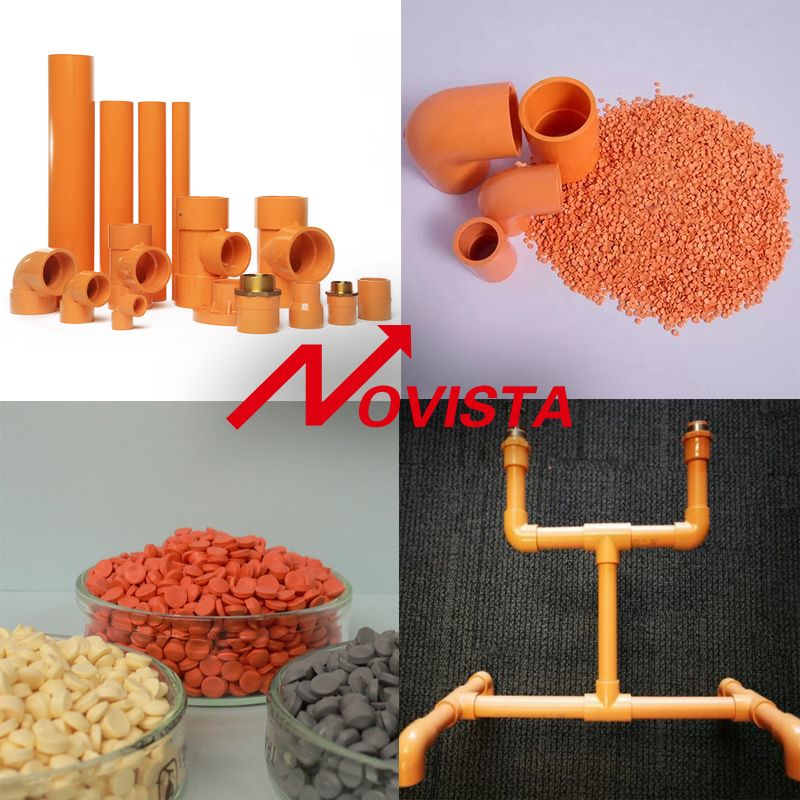PRODUCT CENTER
产品分类
NEWS
新闻资讯News
Do you know the difference between cpvc and pvc
Chlorinated polyvinyl chloride (CPVC) is an important engineering thermoplastic because of its following characteristics:
relatively low cost
high glass transition temperature
high heat distortion temperature
Strong chemical inertness
Excellent mechanical, dielectric, flame and smoke properties
PART.01
What are CPVCs?
Conceptually, CPVC is a chlorinated PVC homopolymer. Typically, chlorine and PVC react according to a basic free radical mechanism, which can be achieved through various methods using thermal and UV energy.
PART.02
Difference between CPVC and PVC?
In PVC, a chlorine atom occupies 25% of the bonds on the carbon backbone, with the rest filled by hydrogen.
CPVC differs from PVC in that about 40% of the bond positions on the backbone are filled with chlorine atoms. The chlorine atoms around the carbon backbone of CPVC are large atoms that protect the chain from attack.
In fact, CPVC is PVC that has been further radically chlorinated, in which atoms of elemental chlorine are continuously added to the polymer resin until it is 57% to 69% by mass chlorine. This further chlorination changes the classification of the resulting plastic material from PVC to CPVC, thereby changing the characteristic properties, operating range, and acceptable application scenarios of CPVC.

✦Enhanced temperature resistance ✦
As the chlorine content in CPVC increases, the glass transition temperature (Tg) -- the region of temperature where the polymer transitions from a hard, glass-like material to a soft, rubber-like material -- increases substantially.
It is the extra chlorine molecules that protect the polymer's carbon backbone, which in turn protects its structural integrity from heat. Increased heat resistance allows CPVC to perform at higher operating pressures.
✦ CPVC Additives ✦
CPVC resin is then infused with additives to enhance many of the inherent properties of CPVC resin while improving its processability.
It is this process that really begins to differentiate CPVC from other thermoplastics and metal piping systems, and allows it to withstand the harsh environments of industrial plants.
However, CPVC often has extremely high melt pressure and viscosity, which means that more efficient lubricants are needed to ensure stable processing of CPVC.
NOVISTACHEM has rich experience in CPVC and provides one-stop solution.
Reduce the viscosity of CPVC and improve the processability of CPVC
Improve CPVC fluidity and increase production efficiency
Avoid paste, wider processing window
Little effect on Vicat softening point
PART.03
Basic physical properties of CPVC
CPVC is inherently inert to acids, bases, salts and aliphatic hydrocarbons, all of which attack metals. It is this inherent chemical resistance, combined with its resistance to temperature and pressure, that allows it to be used in a variety of industrial and commercial applications.
PART.04
CPVC product type
CPVC is a flexible compound that can be manufactured or fabricated into a variety of product forms or geometries using standard molding techniques, primarily extrusion and injection molding.
Pipes and fittings. Corrosion resistance and high temperature resistance remain, while the pressure rating required for the application will vary by pipe diameter, pipe size, compound type and temperature.
air duct. With ever-increasing air emission regulations, the need for reliable flue gas treatment systems is growing rapidly, especially in corrosive environments. CPVC supplies round pipes, fabricated pipe fittings, industrial sheets and welding rods. These components can be designed and manufactured as a whole flue gas treatment system.
Sheets and linings. CPVC's excellent corrosion resistance and fire protection properties can be used in various industrial applications and wrapped in fiber reinforced polyester (FRP).
Custom manufactured and injection molded parts. CPVC cuts cleanly and is easy to weld, making it ideal for products such as tower packing, special exhaust hoods, and holding boxes for acids and bases.
✦Common applications of CPVC ✦
The fundamental physical properties of CPVC make it a common specified choice in applications ranging from chemical and mineral processing plants to residential and hotel hot and cold water piping. CPVC is the problem-free, long-lasting solution for the harshest industrial environments and is often specified for the following industries:
chemical processing. Reliably transports corrosive chemicals under high temperature, high pressure conditions without corrosion issues.
Chlor-alkali. Transport chemicals in some of the most corrosive environments imaginable without corrosion issues.
Commercial hot and cold water pipes. Eliminates corrosion, reduces maintenance costs and improves overall reliability.
Mineral processing. Stands up to the demands of valuables and raw material processing operations.
generate electricity. Long-term withstanding the high pressures and corrosive chemicals commonly used in power plants.
semiconductor. Meets high purity standards for cleanrooms and eliminates concerns caused by aggressive chemicals.
waste water treatment. Eliminates corrosion even when transporting the most aggressive sanitizing chemicals.
✦CPVC installation ✦
The method of installation and connection of CPVC will depend on the type of product, but in general, CPVC has the following installation advantages:
light weight. CPVC is about 1/8 the weight of steel of the same size, which helps reduce worker fatigue and injury and eliminates the need for heavy equipment.
Easy to cut. The composite properties make CPVC easier to cut than metal, allowing for more efficient on-site fabrication.
Easy to install and maintain. The installation of CPVC does not require complex tools, electricity, or highly skilled (and expensive) labor.
safer. No open flame or ignition source is required to join this material.
There are a variety of seam welding options designed to effectively seal components together while maintaining the structural integrity of the material. The recommended installation method will vary by product type:
Pipes and fittings. Solvent bonding, hot air welding, hot plate welding, threading and flanging.
air duct. Solvent bonding, hot air welding, thermoforming, extrusion welding and hot plate welding.





